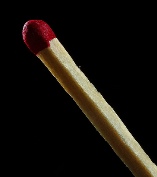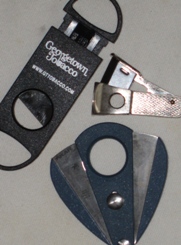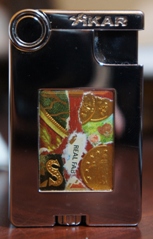[Editors’ Note: In celebration of the five-year anniversary of StogieGuys.com, we’re updating and re-publishing some of our oldest articles, many of which focused on cigar basics. Our hope is to encourage a discussion among readers and reacquaint the community with important cigar fundamentals.]
 Even the most amateur enthusiast knows that cigars need humidity for proper storage. Since they are hydroscopic in nature, cigars will, over time, dry out in an arid climate or absorb moisture in a humid one. Dry cigars yield high combustion temperatures, leaving the smoke hot and acrid on the palate. And wet cigars tend to burn improperly and taste stale.
Even the most amateur enthusiast knows that cigars need humidity for proper storage. Since they are hydroscopic in nature, cigars will, over time, dry out in an arid climate or absorb moisture in a humid one. Dry cigars yield high combustion temperatures, leaving the smoke hot and acrid on the palate. And wet cigars tend to burn improperly and taste stale.
Therefore, we need to aim for a happy medium between too dry and too damp. For the most enjoyable smoke, this equates to 12 to 14 percent of the cigar’s total weight in moisture (or about 60 to 70 percent relative humidity). If you have a humidor, your hygrometer measures relative humidity. But hygrometers, whether mechanical or electronic, can be grossly imprecise and may require adjustment or replacement. So be sure to verify the accuracy of your hygrometer with the salt calibration test.
I’ll begin by mentioning that my degrees in political science and international commerce in no way qualify me to discuss the intricacies of chemistry. So I won’t try to explain why the salt calibration test works. Just please note that it does.
To perform the test on your own hygrometer, you’ll need a few basic items:
(1) Distilled water (purchased from any grocery store)
(2) Coffee stirrer (or other thin, clean object with which to stir)
(3) Bottle cap (Snapple bottle caps work perfectly)
(4) Empty wide-mouth jar with lid (like a clean mayonnaise jar)
(5) Tablespoon of plain table salt
(6) Your hygrometer
Place the tablespoon of salt within the bottle cap and slowly add distilled water to the salt while stirring with the coffee stirrer. Only add just enough water to moisten the salt so that it becomes a thick paste—do not add enough to dissolve the salt.
Next, place the bottle cap with salt/water mixture gently into your wide-mouth jar and add your hygrometer. Make certain the sensor is exposed and is not blocked by the sides of the jar. Seal the jar so there are no leaks, and put it in a place out of direct sunlight and with a stable, cool temperature (like your closet).
Leave the setup undisturbed for a minimum of eight hours. After that, check the reading on the hygrometer through the glass jar. It should read on or near 75 percent relative humidity. Most inexpensive hygrometers are only accurate to within 3 percent, so do not be surprised if yours reads 72 or 78 percent. Whatever it reads plus or minus our 75 percent benchmark is the amount of error.
If your hygrometer has an adjustment meter then, by all means, try to tweak it to exactly 75 percent relative humidity. You should repeat the salt calibration test after making any adjustments. If your hygrometer can’t be adjusted but the reading is close, then my advice is to not worry about it; just remember that your hygrometer is X percent off—either high or low. If the reading is grossly in error and you are unable to adjust it, you need to replace it.
Once you confirm your hygrometer’s accuracy and maintain a relative humidity of about 65 percent in your humidor, your cigars will age properly and be in peak condition when you’re ready to fire them up.
–Patrick A
photo credit: Flickr
 Giving cigars as a gift, even to a known cigar fan, isn’t always as easy as it sounds. Smokers’ tastes in cigars vary widely. Some are averse to specific brands based on bad past experiences, some only like very mild or very strong cigars, some are maduro smokers or Cuban snobs, and some will try any handmade cigar at least once. Unlike buying cigars for yourself, buying cigars for friends, relatives, acquaintances, and co-workers is an entirely different animal. So to help you out, here are three tips for good cigar gift-giving:
Giving cigars as a gift, even to a known cigar fan, isn’t always as easy as it sounds. Smokers’ tastes in cigars vary widely. Some are averse to specific brands based on bad past experiences, some only like very mild or very strong cigars, some are maduro smokers or Cuban snobs, and some will try any handmade cigar at least once. Unlike buying cigars for yourself, buying cigars for friends, relatives, acquaintances, and co-workers is an entirely different animal. So to help you out, here are three tips for good cigar gift-giving:
 There are plenty of firms looking to cash in on this match made in heaven with all kinds of specialty golf cigar gadgets ranging from cigar tees to hold your cigar to golf bag humidors. But dropping extra cash on a gadget is completely unnecessary if you follow a few simple tips.
There are plenty of firms looking to cash in on this match made in heaven with all kinds of specialty golf cigar gadgets ranging from cigar tees to hold your cigar to golf bag humidors. But dropping extra cash on a gadget is completely unnecessary if you follow a few simple tips. Even the most amateur enthusiast knows that cigars need humidity for proper storage. Since they are hydroscopic in nature, cigars will, over time, dry out in an arid climate or absorb moisture in a humid one. Dry cigars yield high combustion temperatures, leaving the smoke hot and acrid on the palate. And wet cigars tend to burn improperly and taste stale.
Even the most amateur enthusiast knows that cigars need humidity for proper storage. Since they are hydroscopic in nature, cigars will, over time, dry out in an arid climate or absorb moisture in a humid one. Dry cigars yield high combustion temperatures, leaving the smoke hot and acrid on the palate. And wet cigars tend to burn improperly and taste stale. Properly lighting a cigar is a bit more complicated than simply striking a match. But taking the time to establish an even, straight burn—and getting in the habit of doing so regularly—will pay dividends in better performing cigars and fewer touch-ups.
Properly lighting a cigar is a bit more complicated than simply striking a match. But taking the time to establish an even, straight burn—and getting in the habit of doing so regularly—will pay dividends in better performing cigars and fewer touch-ups. It’s worth pointing out that, when it comes to cigar cutting, there are many different tools. Some people use specially-crafted cigar scissors, some use a sharp knife, a cigar punch, a V-cutter—some even use their teeth. But the most common tool is the guillotine-style cigar cutter.
It’s worth pointing out that, when it comes to cigar cutting, there are many different tools. Some people use specially-crafted cigar scissors, some use a sharp knife, a cigar punch, a V-cutter—some even use their teeth. But the most common tool is the guillotine-style cigar cutter. Focus on your legislator. Politicians respond to constituents. This is as true at the city council level as it is in the U.S. Senate. Your address should be near the top of all correspondence. As a former Hill staffer said, “You have a voice they want to hear if you have a vote they need.â€
Focus on your legislator. Politicians respond to constituents. This is as true at the city council level as it is in the U.S. Senate. Your address should be near the top of all correspondence. As a former Hill staffer said, “You have a voice they want to hear if you have a vote they need.â€ I asked Tim, co-creator of
I asked Tim, co-creator of  Patrick Ashby
Co-Founder & Editor in Chief
Patrick Ashby
Co-Founder & Editor in Chief Patrick Semmens
Co-Founder & Publisher
Patrick Semmens
Co-Founder & Publisher George Edmonson
Tampa Bureau Chief
George Edmonson
Tampa Bureau Chief